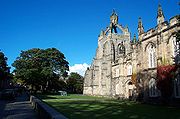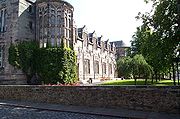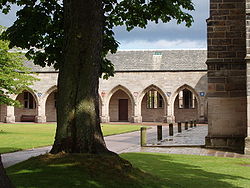
King's College, Aberdeen
Encyclopedia

Old Aberdeen
Old Aberdeen is part of the city of Aberdeen in Scotland. Old Aberdeen was originally a separate burgh, which was erected into a burgh of barony on 26 December 1489. It was incorporated into adjacent Aberdeen by Act of Parliament in 1891...
, Scotland
Scotland
Scotland is a country that is part of the United Kingdom. Occupying the northern third of the island of Great Britain, it shares a border with England to the south and is bounded by the North Sea to the east, the Atlantic Ocean to the north and west, and the North Channel and Irish Sea to the...
is a formerly independent university founded in 1495 and an integral part of the University of Aberdeen
University of Aberdeen
The University of Aberdeen, an ancient university founded in 1495, in Aberdeen, Scotland, is a British university. It is the third oldest university in Scotland, and the fifth oldest in the United Kingdom and wider English-speaking world...
. Its historic buildings are the centrepiece of the University of Aberdeen's Old Aberdeen campus, often known as the King's or King's College campus.
The focal point of the college, as well as its oldest building, is the late 15th century King's College Chapel. A number of other historic buildings remain, with others being subject to renovation and rebuilding in the 18th and 19th centuries. In the early 20th century, a great deal of expansion saw the university buildings increase around the historic college buildings. In the later 20th century, the university expanded dramatically in size, dominating Old Aberdeen and expanding out from the High Street with a number of modern buildings.
History

Aberdeen
Aberdeen is Scotland's third most populous city, one of Scotland's 32 local government council areas and the United Kingdom's 25th most populous city, with an official population estimate of ....
, the third in Scotland
Scotland
Scotland is a country that is part of the United Kingdom. Occupying the northern third of the island of Great Britain, it shares a border with England to the south and is bounded by the North Sea to the east, the Atlantic Ocean to the north and west, and the North Channel and Irish Sea to the...
and the fifth in the United Kingdom
United Kingdom
The United Kingdom of Great Britain and Northern IrelandIn the United Kingdom and Dependencies, other languages have been officially recognised as legitimate autochthonous languages under the European Charter for Regional or Minority Languages...
. In 1495, William Elphinstone
William Elphinstone
William Elphinstone was a Scottish statesman, Bishop of Aberdeen and founder of the University of Aberdeen.He was born in Glasgow, and educated at the University of Glasgow, taking the degree of M.A. in 1452. After practising for a short time as a lawyer in the church courts, he was ordained a...
, the relatively newly appointed Bishop of Aberdeen
Bishop of Aberdeen
The Bishop of Aberdeen was the ecclesiastical head of the Diocese of Aberdeen, one of Scotland's 13 medieval bishoprics, whose first recorded bishop is an early 12th century cleric named Nechtan...
, petitioned Pope Alexander VI on behalf of King James IV
James IV of Scotland
James IV was King of Scots from 11 June 1488 to his death. He is generally regarded as the most successful of the Stewart monarchs of Scotland, but his reign ended with the disastrous defeat at the Battle of Flodden Field, where he became the last monarch from not only Scotland, but also from all...
to create the facility to cure the ignorance he had witnessed within his parish and in the north generally. A papal bull was issued in February 1495 (1491 in the calendar of the day) founding the university; a Royal charter
Royal Charter
A royal charter is a formal document issued by a monarch as letters patent, granting a right or power to an individual or a body corporate. They were, and are still, used to establish significant organizations such as cities or universities. Charters should be distinguished from warrants and...
later that year recognised Aberdeen's status as equal to that of Scotland's two existing universities at Glasgow
University of Glasgow
The University of Glasgow is the fourth-oldest university in the English-speaking world and one of Scotland's four ancient universities. Located in Glasgow, the university was founded in 1451 and is presently one of seventeen British higher education institutions ranked amongst the top 100 of the...
and St Andrews
University of St Andrews
The University of St Andrews, informally referred to as "St Andrews", is the oldest university in Scotland and the third oldest in the English-speaking world after Oxford and Cambridge. The university is situated in the town of St Andrews, Fife, on the east coast of Scotland. It was founded between...
. As a former professor at the University of Paris
University of Paris
The University of Paris was a university located in Paris, France and one of the earliest to be established in Europe. It was founded in the mid 12th century, and officially recognized as a university probably between 1160 and 1250...
, Elphinstone modeled the university very much on the continental European tradition. Hector Boece
Hector Boece
Hector Boece , known in Latin as Hector Boecius or Boethius, was a Scottish philosopher and first Principal of King's College in Aberdeen, a predecessor of the University of Aberdeen.-Biography:He was born in Dundee where he attended school...
, a fellow professor at Paris, was awarded the status of first Principal of the new institution.
It would not be until 1509, with the issuance of a Charter by Elphinstone, that university life at King's truly began. Construction of the Chapel began in 1498; it was consecrated in 1509 and dedicated to St Mary. By 1514, the university had some forty two members in the form of both staff and students.
Following the Reformation
Scottish Reformation
The Scottish Reformation was Scotland's formal break with the Papacy in 1560, and the events surrounding this. It was part of the wider European Protestant Reformation; and in Scotland's case culminated ecclesiastically in the re-establishment of the church along Reformed lines, and politically in...
, King's College was purged of its Roman Catholic staff but remained largely resistant to change in its methods. George Keith
George Keith, 5th Earl Marischal
George Keith, 5th Earl Marischal was a Scottish nobleman and Earl Marischal. He succeeded as earl on 7 October 1581, upon the death of his grandfather, William Keith, 4th Earl Marischal....
, the fifth Earl Marischal
Earl Marischal
The title of Earl Marischal was created in the peerage of Scotland for William Keith, the Great Marischal of Scotland.The office of "Marischal of Scotland" had been held heritably by the senior member of the Keith family since Hervey de Keith, who held the office of Marischal under Malcolm IV and...
however, was a moderniser within the college and supportive of the reforming ideas of Peter Ramus. In April 1593 Keith founded a second university in the city, Marischal College
Marischal College
Marischal College is a building and former university in the centre of the city of Aberdeen in north-east Scotland. The building is owned by the University of Aberdeen and used for ceremonial events...
. Initially, Marischal offered the Principal of King's College a role in selecting its academics, however this was refused by the King's authorities - cited as the first blow in a future rivalry.
In common with Marischal, King's College supported the Jacobite
Jacobitism
Jacobitism was the political movement in Britain dedicated to the restoration of the Stuart kings to the thrones of England, Scotland, later the Kingdom of Great Britain, and the Kingdom of Ireland...
cause and following the defeat of the 1715 rising both were largely purged of their academics and officials.
College buildings

Imperial crown
An Imperial Crown is a crown used for the coronation of emperors.- Imperial Crowns with Mitre :-Legal usage:Throughout the Commonwealth Realms, The Crown is an abstract concept which represents the legal authority for the existence of any government...
, i.e. a closed crown, which appears to make a claim to imperial status for the Scottish monarchy. The original was lost in a storm in 1633, and the present crown is a recreation. King's College retains more medieval woodwork than any other Scottish church, including the choir stalls and screen.
The Cromwell Tower was a building built during the 1650s-60s during the period of the Commonwealth of England, Scotland and Ireland
Commonwealth of England
The Commonwealth of England was the republic which ruled first England, and then Ireland and Scotland from 1649 to 1660. Between 1653–1659 it was known as the Commonwealth of England, Scotland and Ireland...
, although finished after Charles II
Charles II of England
Charles II was monarch of the three kingdoms of England, Scotland, and Ireland.Charles II's father, King Charles I, was executed at Whitehall on 30 January 1649, at the climax of the English Civil War...
had been reinstalled as King. It was originally used for accommodation and had an ornate turret at its top. It continues its function as an observatory to this day.

Old Aberdeen
Old Aberdeen is part of the city of Aberdeen in Scotland. Old Aberdeen was originally a separate burgh, which was erected into a burgh of barony on 26 December 1489. It was incorporated into adjacent Aberdeen by Act of Parliament in 1891...
's High Street and the New Building ("New King's"), constructed in 1913.
King's College is now within the university's main Old Aberdeen
Old Aberdeen
Old Aberdeen is part of the city of Aberdeen in Scotland. Old Aberdeen was originally a separate burgh, which was erected into a burgh of barony on 26 December 1489. It was incorporated into adjacent Aberdeen by Act of Parliament in 1891...
campus and retains its original and historic quadrangle which houses a large conference centre and the university's chapel. Elphinstone Hall is used for functions, dining, and examinations. The rear of King's College is now used as a pavilion for sports. Notably the old college buildings now provide a central focal point to the wider University of Aberdeen campus. While small in comparison with some of the newer constructions and areas, the building maintains a great deal of importance and is central to the atmosphere of the university.
King's College Chapel
King's College Chapel is the main chapel used by the University of Aberdeen. Forming the north side of the original quadrangle of King's College, construction of the chapel began in 1498 and ended with the consecrationConsecration
Consecration is the solemn dedication to a special purpose or service, usually religious. The word "consecration" literally means "to associate with the sacred". Persons, places, or things can be consecrated, and the term is used in various ways by different groups...
of the building in 1509. The most notable architectural feature of the Chapel is its Crown Tower, which has become an icon of the university as a whole. The chapel is dedicated
Dedication
Dedication is the act of consecrating an altar, temple, church or other sacred building. It also refers to the inscription of books or other artifacts when these are specifically addressed or presented to a particular person. This practice, which once was used to gain the patronage and support of...
to the Trinity and the Blessed Virgin Mary in her Nativity, yet also commemorates a number of Scottish and British monarchs, as well as the patrons and founders of the university. The name particularly recalls the College's main patron, King James IV of Scotland
James IV of Scotland
James IV was King of Scots from 11 June 1488 to his death. He is generally regarded as the most successful of the Stewart monarchs of Scotland, but his reign ended with the disastrous defeat at the Battle of Flodden Field, where he became the last monarch from not only Scotland, but also from all...
.
Particularly notable within the chapel are the choir stalls and rood screen
Rood screen
The rood screen is a common feature in late medieval church architecture. It is typically an ornate partition between the chancel and nave, of more or less open tracery constructed of wood, stone, or wrought iron...
, which date back to around 1509. These form the most complete mediaeval church interior in Scotland. Since 1928, the antechapel has been used as the university's war memorial
War memorial
A war memorial is a building, monument, statue or other edifice to celebrate a war or victory, or to commemorate those who died or were injured in war.-Historic usage:...
: five hundred and twenty-four students of the university are commemorated on its walls, having fallen in the First and Second World Wars.
Bishop Elphinstone, the College's founder, and Hector Boece
Hector Boece
Hector Boece , known in Latin as Hector Boecius or Boethius, was a Scottish philosopher and first Principal of King's College in Aberdeen, a predecessor of the University of Aberdeen.-Biography:He was born in Dundee where he attended school...
, its first Principal, are buried at the foot of the chancel
Chancel
In church architecture, the chancel is the space around the altar in the sanctuary at the liturgical east end of a traditional Christian church building...
, although a larger tomb to Elphinstone is located outside the college. The design of the chapel, as well as its date of construction, were designed to evoke Solomon's Temple
Solomon's Temple
Solomon's Temple, also known as the First Temple, was the main temple in ancient Jerusalem, on the Temple Mount , before its destruction by Nebuchadnezzar II after the Siege of Jerusalem of 587 BCE....
.
The King's College Centre
The King's College Conference Centre is a conference and events space within the King's College building, established in 1991 within the former university library, yet maintaining many of the original features of the buildings.The conference centre housed the Scottish Parliament
Scottish Parliament
The Scottish Parliament is the devolved national, unicameral legislature of Scotland, located in the Holyrood area of the capital, Edinburgh. The Parliament, informally referred to as "Holyrood", is a democratically elected body comprising 129 members known as Members of the Scottish Parliament...
between 28 and 30 May 2002 whilst the General Assembly of the Church of Scotland
General Assembly of the Church of Scotland
The General Assembly of the Church of Scotland is the sovereign and highest court of the Church of Scotland, and is thus the Church's governing body[1] An Introduction to Practice and Procedure in the Church of Scotland, A Gordon McGillivray, 2nd Edition .-Church courts:As a Presbyterian church,...
met in its temporary home at New College, Edinburgh
Edinburgh
Edinburgh is the capital city of Scotland, the second largest city in Scotland, and the eighth most populous in the United Kingdom. The City of Edinburgh Council governs one of Scotland's 32 local government council areas. The council area includes urban Edinburgh and a rural area...
. During this time, the parliament was addressed by Her Majesty, the Queen as part of her Golden Jubilee
Golden Jubilee
A Golden Jubilee is a celebration held to mark a 50th anniversary.- In Thailand :King Bhumibol Adulyadej, the world's longest-reigning monarch, celebrated his Golden Jubilee on 9 June 1996.- In the Commonwealth Realms :...
tour of the United Kingdom
United Kingdom
The United Kingdom of Great Britain and Northern IrelandIn the United Kingdom and Dependencies, other languages have been officially recognised as legitimate autochthonous languages under the European Charter for Regional or Minority Languages...
.

